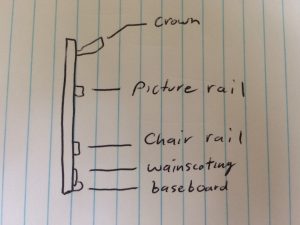Flat construction:
- You have to call a lumber yards for custom size pieces. Home Depot is good for stock sizes.
- 4×8 isn’t the only stock size (longest 6×16)
- Pg. 105-118 in Stock Scenery Handbook shows how to join pieces together.
- Pre-drilling/bolting is best for doing pieces together.
Moulding:
- Moulding shows audience room type/time period. Audience has basic knowledge of scenery setting based on scenery construction.
- Backstage Handbook (pg. 233) shows types of moulding.
Balustrade- Entire stair unit.
Balusters- Made with a rectangular bit and a decorative bit. Has to be cut to a custom size depending on the size of the railing/stairs. 2 per step is common. Extra pieces will probably be necessary for construction.
Handrail – Joint is hidden between handrail and baluster.
Newel post – 6″ x 6″ sq. Can be bought or built. Hollow or solid. Usually decorative and have a topper. Traditionally, topper is removed when the house is paid off.
Nosing- Tread extends past stairs with a rounded shape. Most staircases have it (with the exception of industrial stairs). Wooden stairs have it in homes.
Thicker moulding = fancier. Thinner = more common.
For buying moulding, MDF is cheapest and pressed into shape. All decorative and prone to water damage. Brittle, comes primed so you can’t paint it.
Finger-Jointed Pine (FJ or PFJ) – Pine boards joined together end-to-end. Same cost as MDF mostly, and brittle. Not good for bending. Also can’t be stained.
Soft wood or hard wood. Pine (SW, weaker), Poplar (HW, stronger, used for windows), Oak. One is cheapest, Oak is most expensive.
Foam – Foam comes in solid (cheaper than wood) and flexible (more expensive than wood, used for archways). Light-weight is easier for carving. Flexible foam is custom-ordered.
Shapes:
Shapes come in many varieties. Doors/windows have a specific casing shape.
-
- Broadway designers specify moulding type from Dyke’s catalogue.
- They look for size/dimensions and shadows.
- More lines = fancier, fewer is plainer.
- Chair-rail- protects plaster walls from damage from chairs.
- Picture rail – moulding used to hang pictures on so as not to damage plaster walls. (Don’t use hooks to hang pictures anymore)
- Moulding is bought is a bigger amount than you’ll need. Baseboards need to be big, same with crown moulding.
- Crown moulding is hard to cut for dimensions larger than 6″ x 9″. Bandsaw can be used to cut if a large blade is used. Also, a handsaw can be used.
- Brad nails and narrow crown staples are best used to attach moulding. Can be attached to flat individually in the shop, or at load-in, but that takes up time and can be harder to do on stage.





